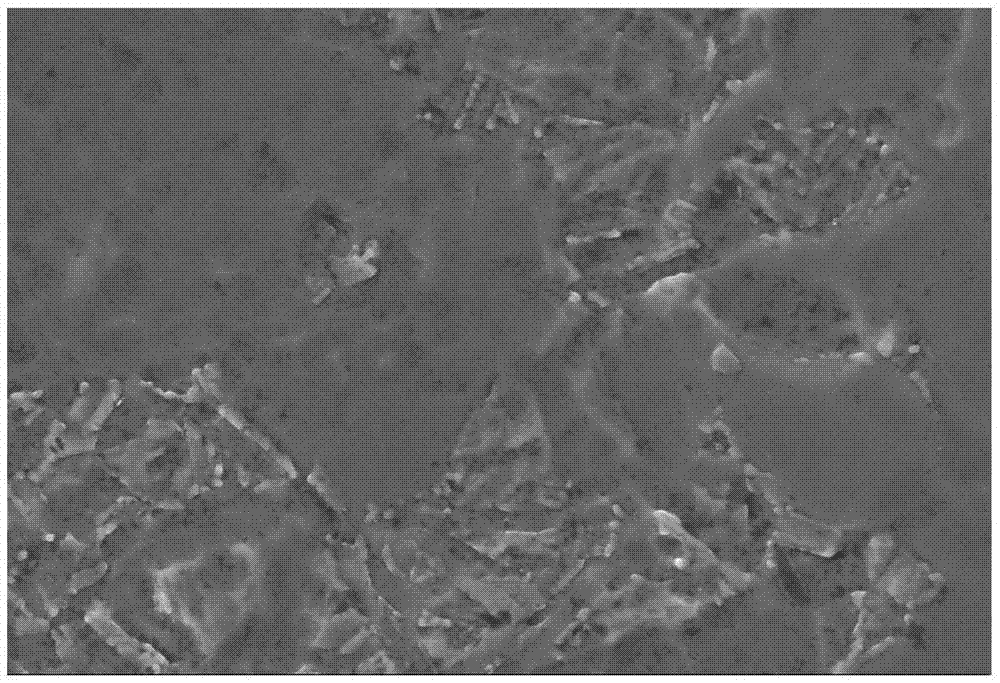Anodic oxidation coloring method free of introducing of elements inconsistent with titanium and titanium alloy base materials
An anodic oxidation and titanium alloy technology, applied in the field of titanium and titanium alloys, can solve the problems of complex process steps, long process routes, and high costs, and achieve the effect of fewer process steps, guaranteed consistency, and low cost
- Summary
- Abstract
- Description
- Claims
- Application Information
AI Technical Summary
Problems solved by technology
Method used
Image
Examples
Embodiment 1
[0037] First, ultrasonically clean in Micro-90 cleaning solution for 10 minutes, and the temperature of ultrasonic cleaning is 70°C. Put the degreased and cleaned miniature bone plate into the pickling solution for 0.5min corrosion at room temperature, and then rinse it with purified water. Hang the cleaned micro-bone plate (TA3) on a special hanger as the anode, stainless steel as the cathode, at a temperature of 15°C and a current density of 10A·dm -2 1. Anodizing and coloring in an anodizing solution with a voltage of 35V for 2 minutes, then rinsed with purified water and dried with an air gun to obtain a colored surface oxide film.
[0038] The pickling solution consists of: 30mL·L -1 hydrofluoric acid, 50mL·L -1 of nitric acid and 50mL·L -1 of hydrogen peroxide.
[0039] The anodic oxidation solution consists of: 50g L -1 tartaric acid, 5mL·L -1 Hydrogen peroxide, 5mL·L -1 of glycerol and 5mL·L -1 of lactic acid.
Embodiment 2
[0041] First, ultrasonically clean in Micro-90 cleaning solution for 10 minutes, and the temperature of ultrasonic cleaning is 75°C. Put the degreased and cleaned miniature bone plate into the acid pickling solution for corrosion for 1 min at room temperature, and then rinse it with purified water. Hang the cleaned miniature bone plate (TA3) on a special hanger as the anode, and stainless steel as the cathode, at a temperature of 20°C and a current density of 5A·dm -2 1. Anodizing and coloring in an anodizing solution with a voltage of 50V for 5 minutes, then rinsed with purified water and dried with an air gun to obtain a colored surface oxide film.
[0042] The pickling solution consists of: 50mL·L -1 hydrofluoric acid, 100mL·L -1of nitric acid and 100mL·L -1 of hydrogen peroxide.
[0043] The anodic oxidation solution consists of: 100g L -1 tartaric acid, 10mL·L -1 Hydrogen peroxide, 10mL·L -1 of glycerol and 10mL·L -1 of lactic acid.
Embodiment 3
[0045] First, ultrasonically clean in Micro-90 cleaning solution for 10 minutes, and the temperature of ultrasonic cleaning is 80°C. Put the degreased and cleaned locking screw (TC4) into the pickling solution for 1.5min corrosion at room temperature, and then rinse it with purified water. Hang the cleaned locking screw (TC4) on a special hanger as the anode, stainless steel as the cathode, at a temperature of 25°C and a current density of 7A·dm -2 1. Anodizing and coloring in an anodizing solution with a voltage of 75V for 7 minutes, then rinsed with purified water and dried with an air gun to obtain a colored surface oxide film.
[0046] The pickling solution consists of: 80mL L -1 hydrofluoric acid, 200mL·L -1 of nitric acid and 200mL·L -1 of hydrogen peroxide.
[0047] The anodic oxidation solution consists of: 150g L -1 tartaric acid, 20mL·L -1 Hydrogen peroxide, 20mL·L -1 of glycerol and 20mL·L -1 of lactic acid.
PUM
| Property | Measurement | Unit |
|---|---|---|
| concentration | aaaaa | aaaaa |
| hardness | aaaaa | aaaaa |
Abstract
Description
Claims
Application Information
 Login to View More
Login to View More - R&D
- Intellectual Property
- Life Sciences
- Materials
- Tech Scout
- Unparalleled Data Quality
- Higher Quality Content
- 60% Fewer Hallucinations
Browse by: Latest US Patents, China's latest patents, Technical Efficacy Thesaurus, Application Domain, Technology Topic, Popular Technical Reports.
© 2025 PatSnap. All rights reserved.Legal|Privacy policy|Modern Slavery Act Transparency Statement|Sitemap|About US| Contact US: help@patsnap.com



